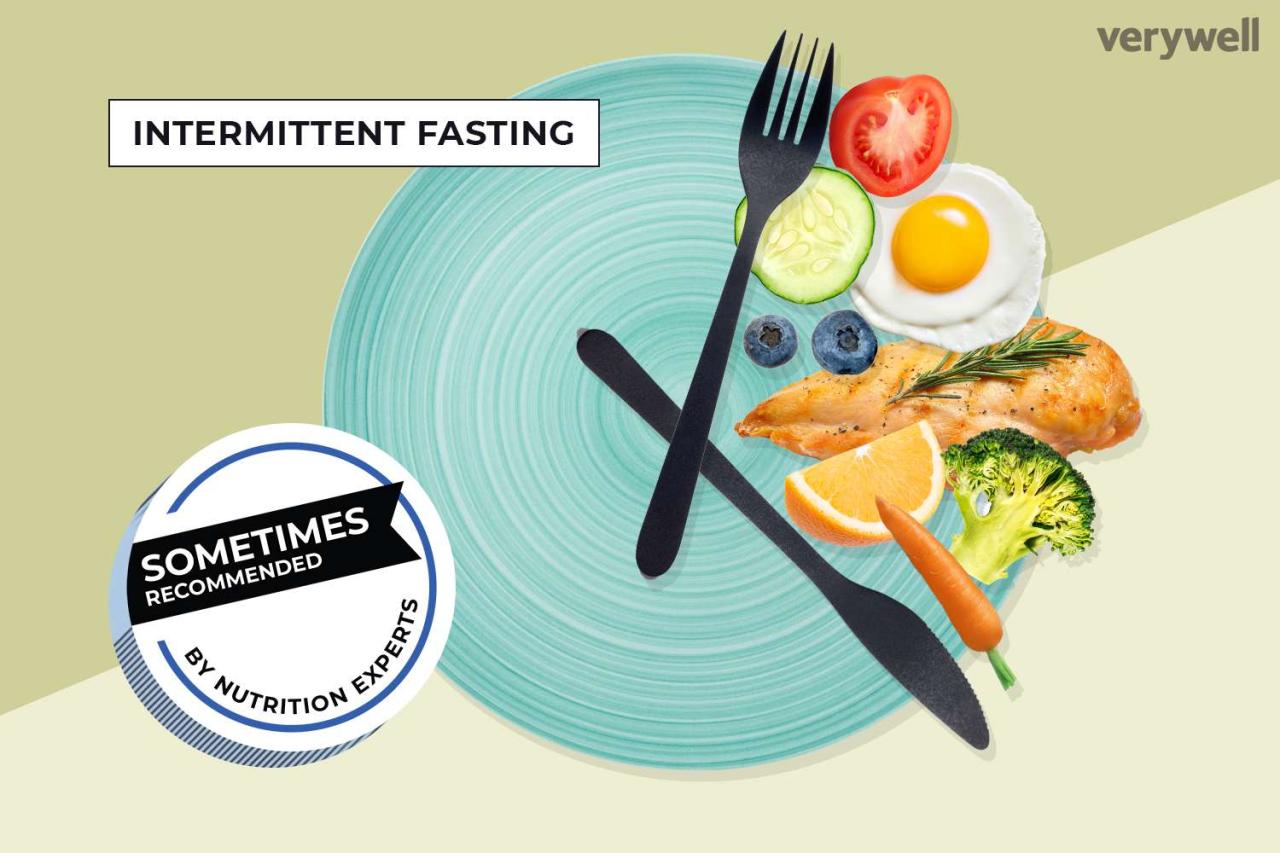Exploring the realm of Intermittent fasting for sustainable lifestyle, this guide aims to provide valuable insights and practical tips on adopting this lifestyle choice.
Delving into the nuances of different methods, nutritional guidelines, exercise routines, and long-term success strategies, this guide offers a holistic view of integrating intermittent fasting into your daily routine.
Benefits of Intermittent Fasting

Intermittent fasting has gained popularity for its numerous health benefits that contribute to a sustainable lifestyle. This eating pattern involves cycles of eating and fasting, which can have a positive impact on overall health and well-being.
Impact on Metabolism
Intermittent fasting has been shown to have a different effect on metabolism compared to traditional calorie restriction diets. By allowing the body to enter a fasting state, it can help increase metabolic rate and promote fat burning. This can lead to weight loss and improved body composition.
Improves Insulin Sensitivity and Reduces Inflammation
Intermittent fasting can also improve insulin sensitivity, which is crucial for regulating blood sugar levels and reducing the risk of type 2 diabetes. Additionally, fasting periods can help reduce inflammation in the body, which is linked to various chronic diseases.
By giving the digestive system a break, intermittent fasting allows the body to repair and rejuvenate, leading to better overall health.
Different Methods of Intermittent Fasting
Intermittent fasting offers various methods that can be tailored to individual preferences and lifestyles, providing flexibility while aiming for sustainable health benefits.
16/8 Fasting
- The 16/8 method involves fasting for 16 hours each day and restricting eating to an 8-hour window.
- This approach is popular for its simplicity and ease of integration into daily routines.
- Psychologically, the consistent daily structure can promote discipline and mindfulness around food choices.
- Research suggests that 16/8 fasting may aid weight loss by regulating insulin levels and promoting fat burning.
5:2 Fasting
- With the 5:2 method, individuals eat normally for 5 days a week and restrict calorie intake to 500-600 calories on the remaining 2 days.
- This intermittent fasting schedule allows for flexibility and may be more feasible for those who prefer regular eating patterns most days.
- Psychologically, the 5:2 approach can reduce feelings of deprivation by incorporating days of normal eating.
- Studies suggest that 5:2 fasting can lead to weight loss, improved metabolic health, and potential longevity benefits.
Alternate Day Fasting
- Alternate day fasting involves alternating between regular eating days and fasting days where calorie intake is greatly reduced or eliminated.
- This method may offer psychological benefits by providing clear boundaries between eating and fasting periods.
- Alternate day fasting has shown promise for weight loss, reducing inflammation, and improving markers of health like cholesterol levels.
- Some individuals may find the strict nature of this approach challenging, but it can be effective when adhered to consistently.
Nutritional Guidelines During Intermittent Fasting
Intermittent fasting can be an effective way to manage weight and improve overall health. It is essential to pay attention to the types of foods consumed during eating windows to ensure the body receives adequate nutrition and sustenance.
Recommended Foods to Consume During Eating Windows
- Lean proteins such as chicken, turkey, fish, tofu, and legumes provide essential amino acids for muscle repair and growth.
- Fruits and vegetables rich in vitamins, minerals, and antioxidants help support the immune system and overall health.
- Whole grains like quinoa, brown rice, and oats provide sustained energy throughout the fasting period.
- Healthy fats from sources like avocados, nuts, seeds, and olive oil aid in satiety and support brain function.
Importance of Staying Hydrated and Consuming Micronutrients
Staying hydrated is crucial during intermittent fasting to support proper digestion, metabolism, and overall well-being. Consuming micronutrients such as vitamins and minerals is essential for various bodily functions, even during fasting periods.
Examples of Balanced Meals for Sustainable Energy Levels
| Meal | Components |
|---|---|
| Grilled Chicken Salad | Grilled chicken breast, mixed greens, cherry tomatoes, cucumber, olive oil dressing |
| Quinoa Bowl | Quinoa, black beans, bell peppers, avocado slices, lime vinaigrette |
| Salmon with Roasted Vegetables | Baked salmon fillet, roasted broccoli, carrots, sweet potatoes, drizzled with olive oil |
Exercise and Intermittent Fasting
Intermittent fasting can have a significant impact on exercise performance and muscle growth when done correctly. It is essential to understand the best workout strategies to complement an intermittent fasting routine and maximize physical fitness gains.
Optimal Workout Strategies
- Aim to schedule your workouts during the feeding window to ensure you have enough energy and nutrients for optimal performance.
- Consider high-intensity interval training (HIIT) or strength training exercises, as they can help preserve muscle mass and improve fat loss during fasting periods.
- Stay hydrated before, during, and after your workouts to maintain performance and prevent dehydration.
Effects of Fasting on Muscle Growth and Performance
- During fasting periods, the body may utilize stored fat for energy, which can potentially impact muscle growth if not enough protein is consumed during feeding windows.
- Intermittent fasting may lead to a decrease in muscle protein synthesis, especially if workouts are not strategically planned around feeding times.
- However, when combined with proper nutrition and workout routines, intermittent fasting can help maintain muscle mass and improve overall body composition.
Tips for Maximizing Physical Fitness Gains
- Ensure you are consuming an adequate amount of protein during feeding windows to support muscle growth and repair.
- Listen to your body and adjust your workout intensity and duration based on how you feel during fasting periods.
- Consider supplementing with branched-chain amino acids (BCAAs) before or after workouts to prevent muscle breakdown and enhance recovery.
Sustainability and Long-Term Success

Intermittent fasting can be a sustainable lifestyle choice when approached thoughtfully and with the right strategies in place. Consistency is key when aiming for long-term success with intermittent fasting.
Maintaining Consistency
- Establish a routine: Set specific fasting and eating windows that align with your daily schedule and stick to them.
- Plan your meals: Preparing meals in advance can help you make healthier food choices and prevent impulsive eating.
- Stay hydrated: Drink plenty of water during fasting periods to stay hydrated and curb hunger.
- Monitor progress: Keep track of your fasting hours and meals to stay accountable and motivated.
Overcoming Challenges
- Cravings: Distract yourself with activities, drink water, or have a small, healthy snack to manage cravings.
- Social gatherings: Opt for healthier options, communicate your fasting schedule to friends and family, and focus on enjoying the company rather than the food.
- Travel: Plan ahead by packing nutritious snacks, adjusting your fasting schedule to match time zone changes, and making mindful choices when dining out.
Integration in Social Gatherings and Travel Plans
- At social gatherings: Choose nutrient-dense foods, practice mindful eating, and engage in conversations to shift the focus away from food.
- During travel: Pack portable snacks like nuts or fruits, research restaurants with healthy options at your destination, and be flexible with your fasting schedule to adapt to different time zones.
Closing Summary
In conclusion, Intermittent fasting can be a transformative practice when done mindfully and sustainably. By understanding the benefits, embracing various methods, following nutritional guidelines, incorporating exercise, and ensuring long-term sustainability, you can harness the power of intermittent fasting for a healthier and more balanced lifestyle.
Essential FAQs
What are the potential psychological benefits of intermittent fasting?
Intermittent fasting can improve mental clarity, focus, and overall mood by regulating hormones and promoting neuronal health.
How can intermittent fasting be integrated into social gatherings?
During social events, you can choose healthier options, practice portion control, and plan your fasting schedule accordingly to stay on track with intermittent fasting goals.
What are some challenges people may face with intermittent fasting?
Common challenges include initial hunger pangs, adjusting to new eating patterns, and social pressures. Overcoming these challenges gradually can lead to successful long-term intermittent fasting.






